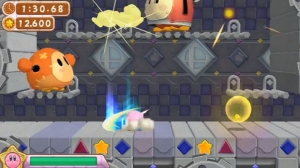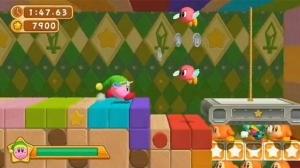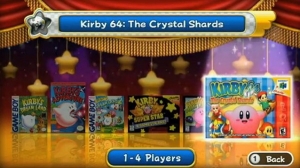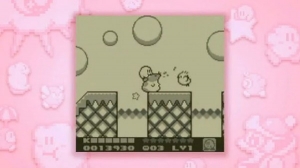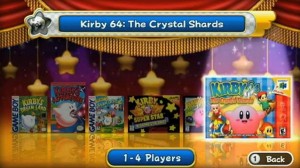 There’s something to be said for keeping it simple. The joy of a character design as easy to draw and manipulate as Kirby is that it can be used in so many ways. Nintendo certainly knows this and all but admitted it in their famous intro for Kirby’s Adventure:
There’s something to be said for keeping it simple. The joy of a character design as easy to draw and manipulate as Kirby is that it can be used in so many ways. Nintendo certainly knows this and all but admitted it in their famous intro for Kirby’s Adventure:
First you draw a circle
Then you dot the eyes
Add a great big smile
And presto, it’s Kirby!
It’s fascinating to see the evolution of Kirby throughout Kirby’s Dream Collection. The six games included all play similarly to a fault (more on that later), but they become markedly more refined with each iteration. In fact, in the first game in the set, Kirby’s Dream Land, Kirby doesn’t even have his trademark ability to swallow enemies and copy their powers. He gets all this and more in the remaining games, which include:
– Kirby’s Adventure
– Kirby’s Dream Land 2
– Kirby Super Star
– Kirby’s Dream Land 3
– Kirby 64: The Crystal Shards
Before diving into the discussion of the meat of the collection, though, the extras deserve a mention. Half the fun of collections is seeing the history behind iconic franchises and the stories of how they came to be. Game collections are good excuses to brush off some old archives of sketches and proposals that allow a glimpse into the creative process behind beloved characters and series.
Nintendo didn’t totally drop the ball on this, but the extras are disappointing. The only non-game present is an interactive timeline of all of Kirby’s games along with seemingly random historical events that happened in the same year. Each game entry has a short video and description with little else. It’s a comprehensive record of the 20-odd Kirby games, but anyone browsing the extensive timeline will have the same question I did:
Why are there only 6 games in Kirby’s Dream Collection?
Money, dear reader. Every game is available or will shortly be available on either the Wii or 3DS Virtual Console. All six games present in Kirby’s Dream Collection cost a total of ~$39 together when bought on the Virtual Console, meaning that gamers are paying $1 extra for an artbook, a soundtrack CD, a timeline, the privilege of playing these games on a TV, a few episodes of the Kirby anime, and the challenge stages.
The challenge stages will be familiar to those who played Kirby: Return to Dream Land. Each challenge stage is a 2D platforming level a couple minutes long in length, requiring players to either race an opponent or beat the stage while attaining as high a score as possible. Players are limited to only a single Kirby power. These stages are fun but shallow, and their limited number will not hold the interest of players uninterested in high score challenges.
This leaves the games themselves, seeing as Nintendo didn’t even include any unlockables upon beating the games. Every single one of them is a straight emulation as the game appeared on its initial system. For the Game Boy games, this means no Super Game Boy or Game Boy Color palette, which is particularly disappointing in Kirby’s Dream Land 2.
For all the missed opportunities in this collection, however, the brilliance of the Kirby franchise does shine through in the six games present. With one exception, every game is highly polished with tight controls, fitting perfectly in the Wiimote, Gamecube, or Classic Controller control scheme.
Kirby’s Dream Land introduces many of the characters and themes of the series, but it’s by far the shortest of the bunch and can be easily completed in under 2 hours. It’s pretty vanilla, much like the decidedly non-pink, early design Kirby in the game. Despite its flaws, it’s still an entertaining early 90’s platformer.
Kirby’s Adventure, on the other hand, has not aged well. The late-NES game may have introduced Kirby’s copy power (and his accepted pink color and fluff-ball design), but it tries to do too much and achieves too little in the process. It borrows many artistic assets and levels (4 out of 5!) whole-sale from Dream Land, and all the good parts from this game were lifted and reused in Kirby’s Dream Land 2. For some reason, it has unresponsive control issues as well, and I found myself frequently being unable to jump or use my power when I wanted to. If ever there was a game to skip in this collection, it’s this one.
Kirby’s Dream Land 2 adds in Kirby’s animal friends and contains probably the most complete and refined set of levels in the collection. It’s arguably too easy, but it has many interesting worlds and puzzles without being overwhelmed by collectibles like the next Dream Land game. Kirby’s Dream Land 2 takes the concepts introduced in Kirby’s Adventure and the controls of Kirby’s Dream Land 1 and merges them together into possibly the finest Game Boy 2D platformer ever made, which is no small praise.
Kirby Super Star is the fan favorite of the franchise, and it’s not difficult to see why. It might not be a complete, cohesive game, but between the perfectly translated Kirby gameplay on the SNES and the diversity of games like the spelunking treasure collect-fest of “The Great Cave Offensive” and the utter havoc of “The Revenge of Metaknight,” where Kirby takes on an entire army with a flying battleship, it’s easy to see why many consider this the zenith of Nintendo’s pink puffball. Fair warning: One of the 8 games is a remake of Kirby’s Dream Land, so players who play the games in order will be treated to the same set of levels for the third time after Dream Land and Adventure.
Kirby’s Dream Land 3 should really be better than it is. It’s by far the best-looking game in the collection with its stylized sketchbook art direction. No game before Kirby’s Epic Yarn encapsulated the joyful silliness of Kirby in the way it looked more than this game does. Unfortunately, it’s too easy to get caught up in collecting items throughout the levels to get the true ending, and many of those items are even easier to miss. Powers are nerfed from Dream Land 2 and Super Star, and as a result, the game isn’t as much fun. The levels are adequate but less inspired than the normal Kirby standard. It’s a shame, because it has potential.
Finally, Kirby 64: The Crystal Shards attempts to bring Kirby into the 3rd dimension with its graphics, even if its gameplay is the same 2D gameplay as the rest. It’s still a bit of a collect-fest, but Nintendo appears to have learned its lesson since Dream Land 3, even allowing players to mix powers together for a different result, making the copy ability zanier than ever before. It’s a little slower-paced than the other Kirby games, but it’s still quite fun.
For fans of Kirby and 2D platforming, Kirby’s Dream Collection is a worthy purchase. The Kirby games are some of the best sidescrollers out there. The games are emulated well, and it’s a pleasure to relive a series with gameplay that holds up 20 years later. Those who haven’t played a Kirby game are in for even more of a treat, as they get to enjoy the series for the first time. However, I would recommend skipping both Kirby’s Adventure and the first game of Kirby Super Star to avoid the redundancies mentioned earlier.
That said, it’s curious that Nintendo didn’t include more games. Nintendo’s experimented with Kirby arguably more than any other character they have, placing him in a pinball game a breakout clone, and even a golf-inspired puzzle game, and they’re all fantastic, yet none of them have any presence past a short movie in their timeline entry. Nintendo didn’t need to put them all in the collection, but even a few as unlockables would have been appreciated. Still, if they could only pick six games, these are pretty close to the best.
Gameplay
Graphics
Sound
Overall

